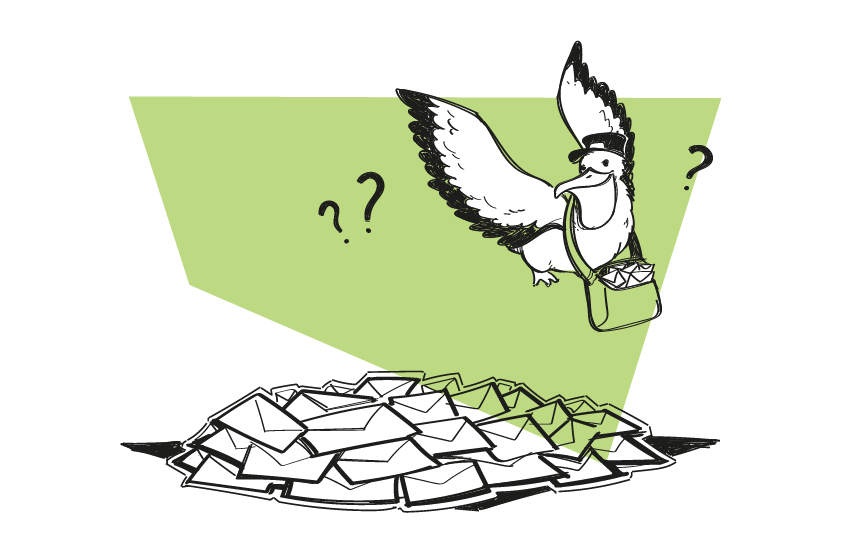Many cold email senders seem to think that a great opening message is what you need to master outbound email outreach. Well, it is indeed – but it’s also not enough.
If the first email didn’t do the job, a follow-up is your second chance to get a ‘yes’.
This is your guide to the world of follow-ups, aka all you need to know when you send follow-ups after not getting a response.
Here’s what you’ll learn:
- why you shouldn’t skip follow-ups
- what you should realize before you start sending them
- how to write engaging follow-up messages that make people open, read, and respond
- how many follow-ups you should send
- how often you should send them
Why should you always send follow-up emails?
According to our research, even one follow-up email can increase your reply rate by 22%.
And trust me – not that many people do actually follow up with prospects.
As pointed out by Christine Georghiou in her article, “70 percent of sales emails stop after the first attempt”. Considering that not all cold emails are sent for sales purposes, the overall rate of cold emails that are never followed-up may be even higher than that.
In short, hardly anyone sends follow-up emails.
Which means that if you do follow up after sending the opening message, you are in a quite limited group of people who do that.
You actually show more interest in starting a relation with your prospect than the majority of cold email senders that ever reached out to them. This means that just by sending follow-ups, you actually stand out from the crowd.
And this can make your prospects see you differently than your competition.
- First of all, just by the fact that you do more than most people who contact them, you make them notice you.
- Second of all, you make them feel you actually care about their reaction or lack thereof. You make them feel you didn’t just send a huge amount of messages in bulk and forgot about it the moment you hit “Send”.
You make them feel you are not bots, but real human beings who actually care more personally about the people you’re addressing.
But won’t following up annoy people?
Sometimes you may feel that follow-ups will make your prospects feel stalked and downright angry. I felt that when I first started sending follow-up emails.
In practice, this is rarely the case. If you’re offering value to your potential customers, usually they’ll feel grateful, enjoy your interest in them, and admire your persistence.
This is an actual reply Cathy, our CMO, once got:
Hi Cathy, thank you so much for following up, that is how you get anywhere in life. I’ll reply with a 2 just because right now is very busy but I would like to look into this in mid June. Thank you again for sending me this information, would definitely like to do a trial in the future.
Why do your emails get no response?
There are three basic reasons for that:
- The problem may lie in the content of your email. Perhaps it didn’t hit the right chord and recipients didn’t find it interesting enough. Or they need more touchpoints to get engaged
- Your addressee is a busy person and simply forgot to reply or missed your email among hundreds of other messages
- Your email landed in SPAM or the promotions tab and recipients never saw it
In the first two cases, you can get a second chance to catch their attention by sending a follow-up email after they haven’t replied.
In the last case, the problem is a bit more complex and requires some investigation to be done first. To learn more about spotting & solving email deliverability problems, read this blog post.
How to write a follow-up email after no response
So now you know why following up with your prospects is crucial for the effectiveness of your campaign and what the possible reasons you’re not getting responses are.
But what should an actual sales follow-up email be like? How to tell your prospects ‘Hey, I’m still here waiting for you to reply’ without being creepy or annoying… or both?
Here’s Cathy explaining how to write a follow-up email after no response:
What to write in the subject line of a follow-up email
It’s best to send your follow-ups in the same thread as the opening email to make it easy for prospects to refer to your previous message. It’ll also help you maintain a logical connection between all your follow-ups.
This makes the choice of a subject line pretty straightforward – stick to the one you came up with for the opening email.
For inspiration, check our selection of 15 best cold email subject lines we’ve come across >>
What to write in the follow-up email itself
I can’t count how many times I got a follow-up email saying “Just wanted to follow up on my previous email” or “Just checking in”. Yes, it’s short and immediately gets to the point, but it’s also so overused that it became one of the cold email cliches.
There’s also one more problem: this approach doesn’t solve the first case of why people don’t respond, namely because your message didn’t catch their interest.
So when writing a follow-up, keep in mind these 5 crucial things:
- Keep it short – just like in the opening email, or shorter if possible
- Keep it simple and easy to respond to – just like in the opening message, give them a clear instruction to the next step or a simple question to answer
- Keep it coherent – make sure the follow-up is logically connected with the previous message. Don’t forget to repeat the same CTA as in the opening email
- Keep it natural – your messages should not sound like automatic follow-ups or sales formulae learned by heart. You know the specifics of your group of prospects, you know how they speak and write. Adjust your opening message and sales follow-ups to them. They need to feel they are about to respond to a real person
- Keep it valuable – don’t treat a follow-up as a reminder that a prospect hasn’t replied to your previous email yet. That’s annoying. Try to smuggle some value into your follow-ups message instead
Since you don’t really know the exact reason why people didn’t respond to your initial email, it’s wiser to write a follow-up that brings additional value and use a second chance to catch their interest, rather than keep reminding them that you’re waiting for their response.
For example, mention another benefit of your product, send them a case study of how it helped a similar company or link to a video that shows how to use your product and what they can gain from it.
Here’s a follow-up email template for no response that perfectly illustrates my point:
“{{First_Name}}, If Thursday doesn’t work for you, what about a quick call on Monday afternoon? Let me know. In the meantime, I’d like to share with you a story of Pelican.io, a fintech startup from Poland similar to {{COMPANY}}, who struggled with the inefficiency of their lead generation process before automating it with our tool. Read it here: [link]”
Ready to try it out and see the results for yourself?
How long should you wait for an email response?
Give your contacts at least 1-3 days to answer your email. Following up too soon will make you look pushy or even intrusive. Nobody likes that.
Having said that — try not to wait too long with sending a follow-up email either, because your recipient may lose the context.
How many follow-up emails is too many?
I know what you’re wondering… Where is the line between persistence and stalking?
There’s no rule stating the maximum number of follow-ups. It’s rather a matter of common sense.
Also, as proved by our research, the 5th, 6th or 7th follow-up email brings just a tiny increase in the reply rate, so it may not be worth your time to send more than 3 or 4 follow-ups. 2 0r 3 seems to be the optimal number. Top performers usually send just that.
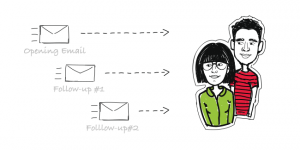
Following up, as well as cold emailing in general, requires lots and lots of individual testing. So many factors affect the efficiency of your cold email campaigns, and it is you who has to discover what works best for your own group of prospects.
It seems like a better idea to work on the quality of each email, rather than quantity because if you overdo it, you may get labeled as a spammer by one of the irritated addressees — and that’s the last thing you want.
How often should you send follow-up emails?
Again, it depends on the purpose of your email and the characteristics of your group of prospects. Elliot Bell in his post, artfully entitled “Pleasantly persistent…”, points out that we should give our addressee at least a week to reply to our first email before we send the first follow-up.
On the other hand, Steli Efti proposes a sequence like this:
“Day 1: First follow up (+2)
Day 3: Follow up (+4)
Day 7: Follow up (+7)
Day 14: Follow up (+14)
Day 28: Follow up (+30)
Day 58: Follow up (+30)
… (from there on once a month).”
For yet another perspective, at 52Challenges we used a 3-email sequence (an opening message plus two follow-ups), and we sent the first follow-up after 3 days and the second one after 7 days. We saw reply rates up to 30%.
Additionally, in the third email, we gave the prospects an easy way to express explicitly they are not interested.
Keep in mind that you’re addressing people
All your prospects are people. You can’t ignore that. They are very busy running their own business and get dozens of emails every day. Sometimes it takes a couple of days to reply to emails that are not ‘top priority’.
And if you address totally cold prospects, you can be sure that your emails are most certainly NOT ‘top priority’ on their list. So be patient and give them some time to react before you send them another follow-up.
The trick is to discover the optimal frequency for your group of prospects. If you send the follow-ups too frequently, they may feel stalked – and that’s not what you aim at (remember, “pleasantly persistent” is not pushy).
If you wait too long, they may forget who you were at all and if they are confused they won’t be eager to reply, either. (Especially because some evil geniuses of spam somehow figured that if they send us an email with the subject starting with “Re:”, we will automatically feel the need to reply to them… Well, we won’t. Not if the “Re:” email is the first one they have ever sent us.)
How to send follow-up emails
Basically, there are two ways you can send follow-ups:
- manually (boo! Too much hassle if you have a big or even medium-sized list)
- by scheduling an automated follow-up sequence in a tool dedicated to cold emailing, like Woodpecker
Which one you choose depends on how many recipients you target and how much time you can devote to it.
Sending follow-up emails manually is de facto only possible on a small scale. And if you have a lot of patience, strong nerves, and above-average organizational skills. Trust us, we’ve been there and done that. Actually, that’s how the idea for Woodpecker came into being. You can read the story here.
If you target more than just a handful of people, it’s much easier to prepare a follow-up sequence and let the tool take care of the sending for you.
You won’t have to keep track of when was the last time you followed up, who already responded and who you should follow up with again.
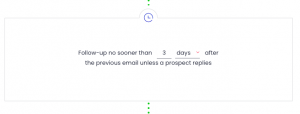
You also get insights about how your emails perform, so you can use the saved time on A/B testing and polishing them up to improve the results. It’s like you hired an assistant who works round the clock for you.
What’s in it for you
I wish I could tell you there is a golden sequence of follow-ups you could use for your own campaign. Unfortunately, there is not. You may obviously take advice from blog posts (like this one), videos and online courses, and test it out in your own campaigns.
But here’s another piece of advice: don’t stick to the first sequence you try out.
- change the frequency
- change the number of follow-up touches
- experiment with the copy
That’s the only way to find out what brings you optimal results. You may find out that your first guess was the best one, but that’s still worth discovering. Keep in mind the ‘pleasantly persistent’, and don’t be afraid of following up.
And if you’d like to go even deeper into the topic of sales follow-up emails — grab our Sales Follow-up Guide.
FAQ
What should I include in a follow-up email template?
A follow-up email template should start with a strong subject line, followed by a personalized greeting, recalling the pleasure of speaking with them. Include a brief recap of your previous interaction, a clear call to action, and key details like your contact info and company name. Conclude with a friendly reminder or ‘looking forward to hearing from you’.
How can I write a polite follow-up email after a meeting request?
Begin with a personalized greeting, expressing pleasure at having spoken with them or met them. Politely follow up on the meeting request by briefly recapping the main points and reiterating the pain point or opportunity. End with a gentle reminder of the desired outcome and a clear call to action.
Can you provide an example of a successful follow-up email subject line?
A successful follow-up email subject line could be, “Re: Our Last Conversation – Next Steps?” This subject line is direct, helps jog the recipient’s memory about the previous interaction, and indicates that the email contains important follow-up information.
What are some effective follow-up email examples for sales professionals?
Sales professionals can use follow-up emails to remind the email recipient of the immediate value discussed. For example, after a product demo, send an email with a subject line like “Further to Our Demo – Additional Resources”. Include links to relevant resources and offer to answer any further questions.
How should I format a follow-up email to avoid spam filters?
Keep your follow-up email format simple and direct. Use a clear subject line, avoid excessive links, and ensure your email template is professional. Personalize the email to resonate with your target audience and address their specific needs or pain points.
Is it okay to use the same subject line for follow-up email samples?
Using the same subject line can be effective for continuity, especially if it’s a direct continuation of a previous conversation. However, if you’re sending numerous follow-ups, consider varying the subject line to avoid seeming repetitive.
What’s a gentle way to follow up in an email message?
Start with a phrase like, “I hope you’re having a great week,” followed by a gentle reminder of your previous email. Mention that you understand they’re busy but would appreciate any update they can provide. End with “Kind regards” or “Best wishes”.
How long should I wait before sending a follow-up email?
The waiting period before sending a follow-up email typically depends on the context. Generally, waiting a week is advisable. It gives the email recipient enough time to respond to your initial message without feeling overwhelmed by too many follow-ups.
How can I ensure my follow-up email campaign resonates with my target audience?
Tailor your follow-up email campaign to address the specific needs and pain points of your target audience. Use insights from a discovery call or initial interaction, and reflect these in your follow-up emails. Personalized greetings and referencing previous conversations can significantly impact your audience’s engagement.
What are some key elements to include in a follow-up email after no response?
In a follow-up email after no response, briefly recap your previous message, provide additional context or value, and include a clear call to action. A subject line like “Just Checking In – Any Updates?” can be effective. Maintain a friendly and professional tone, and express your eagerness to hear back.
READ ALSO
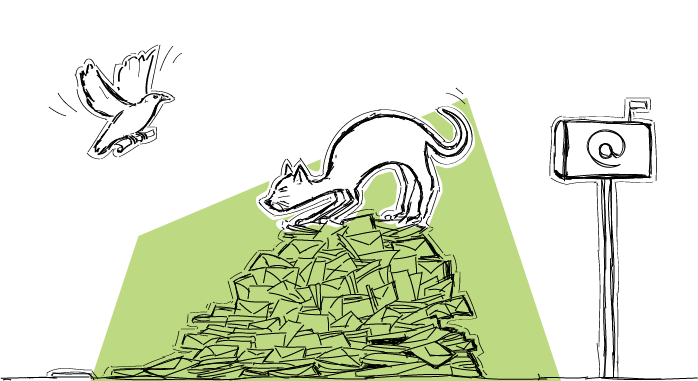
10 Reasons Why Your Cold Emails Are Getting No Response
This week we have a guest post by Nina Cvijovic, who is a researcher and writer at Etools. Nina analyzed 10 reasons why your outbound email campaigns may not be reaching the response rate you expect them to, or are not generating any responses at all. Either way, there's always a field for improvement in cold emailing. So go through the 10 checkpoints below, and read some advice on how your response rates can be improved.
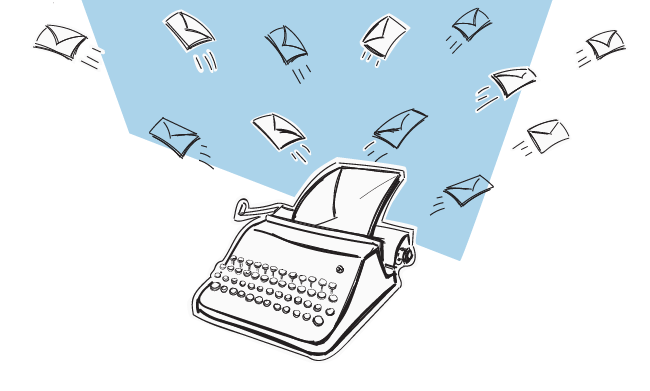
10 Tips to Write a Cold Sales Email From a Copywriter
Cold email copy can make or break your email campaign. A perfectly targeted prospect base won’t guarantee success if your message doesn’t catch their interest. Unfortunately, many cold emails fail to do that. The most common problems with cold email copy that I've come across are the lack of clarity, impersonality, unnecessary wordiness and egocentrism. These things make prospects delete the message without even reading it till the end. In this blog post, I want to share with you some copywriting tips that will help you write more prospect-oriented, valuable and engaging sales emails that will get opened, read and replied to.
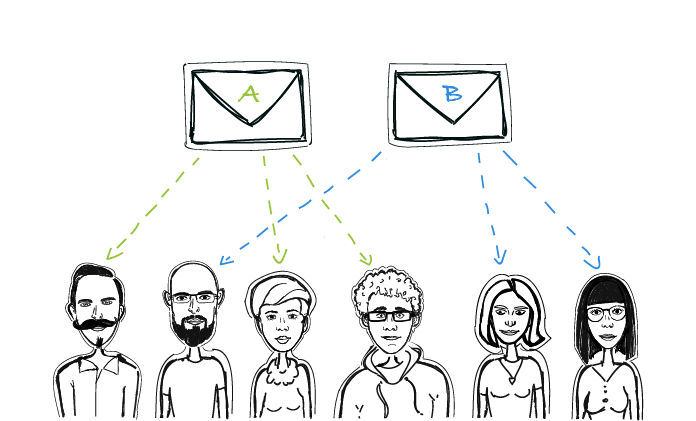
A/B Testing in Cold Email: How to Optimize Our Copy to Get More Replies?
Split tests, or A/B tests, are a well-known method for website’s or newsletter’s copy optimization. But cold email copy also needs constant changes if it is to bring optimal effects. Here’s a little about split testing in cold email: which parts of our email can be tested, how can we test most effectively, what tools can we use for convenient comparison of results?

